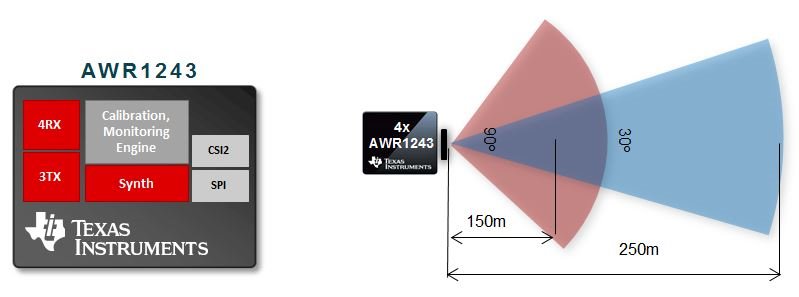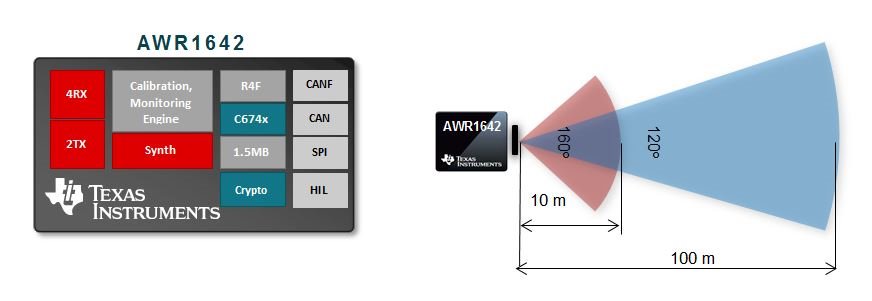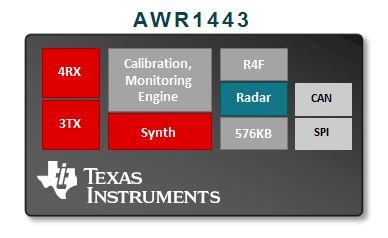-
Giving Cars Advanced Vision through TI mmWave Sensors
Giving Cars Advanced Vision through TI mmWave Sensors
Kishore
Advanced driver assistance systems (ADAS) have rapidly evolved over the last five years, from comfort functions, such as adaptive cruise control (ACC), to safety-enhancing functions such as emergency braking and newer applications like pedestrian detection and 360-degree sensing. Previous millimeter wave (mmWave) sensors which enabled these applications were all discrete, with the transmitters, receivers and the processing components as separate units. This made the design process of the mmWave sensor complex and the solution big and bulky.
By bucking the trend of traditional silicon germanium- (SiGe) based sensor technology, TI’s RFCMOS-based radar sensors bring in a high level of digital and analog integration to enable high output power, low power consumption (50 percent less compared to existing solutions in market) and low-phase noise, in turn resulting in accurate and ultra-high resolution sensing enabling a safer and advanced driving experience.
With three devices in TI’s mmWave sensors portfolio, AWR1243, AWR1443 and AWR1642 sensors, developers can choose the right range and level of sensitivity for their design needs.
The AWR1x sensors work on frequency modulated continuous waveform (FMCW) technique in the 76 – 81 GHz band and have the following features:
- Closedloop phase locked loop (PLL) enables linear and highly precise chirps which helps with increased range accuracy.
- Ability to sweep the complete 4 GHz chirp bandwidth, which enables detection of objects spaced less than 5 cm apart.
- A complex receiver architecture that enables jamming or interference detection in a dense sensor environment.
- An intelligent self-monitoring system that self-calibrates across voltages and temperatures.
Long- and Mid-range Sensing Applications
Imagine driving at a high speed on a highway with automatic cruise control. If any obstacles were to appear in the vicinity of your car at a certain distance or curvature, the mmWave sensor can help detect this obstacle in a matter of milliseconds (ms). The central intelligent system will then alert the driver within 100 ms to take the necessary action to help alert the driver of possible danger.
The AWR1243 mmWave device, as displayed in Figure 1, is a radar front-end sensor with three transmitter and four receiver antennas targeted toward long and mid-range radar applications like ACC and automatic emergency braking (AEB) which are required for autonomous driving. It comes with the camera serial interface-2 (CSI-2)/low-voltage differential signaling (LVDS), I2C and serial peripheral interface (SPI). The monolithic mmWave integrated circuit (MMIC) comes with an inbuilt calibration and monitoring engine and is coupled with an external processor such as the TI TDA3 processor. Cascading multiple AWR1243 sensors can easily achieve farther range and better angular resolution in an application such as imaging radar for automated highway driving.
 Figure 1 AWR1243 mmWave Transceiver, the Range and Field of View Capability
Figure 1 AWR1243 mmWave Transceiver, the Range and Field of View CapabilityShort-range Applications
According to the Eno Center for Transportation, about 90 percent of car accidents are due to human error; many of the accidents caused by driver distraction. Cameras, 24 GHz radar and ultrasonic sensors exist on the market to help address these problems, but the products may not be the best fit. This is where TI’s 77 GHz single-chip digital signal processor (DSP) integrated solution can make a difference. Our mmWave sensors can work under any environmental condition like day, night, snow, rain, fog and dust and provide highly accurate measurements in a small form factor with low-power consumption.
The TI AWR1642 sensor offers the following features compared to a 24 GHz sensor:
- 33 percent smaller form factor
- 50 percent less power consumption
- 10x more range accuracy
- Cost-optimized bill of materials (BOM)
The AWR1642 is a high-end, single-chip mmWave sensor, as show in Figure 2, with two transmitter and four receiver antennas targeted toward short-range and ultra-short-range applications like blind-spot detection, lane-change assistance, cross-traffic alert and stop and go. It comes with CAN, CAN flexible data rate (CAN FD) and SPI interfaces, as well as 1.5 MB of on-chip RAM. An ARM® Cortex®-R4F and TI C674x DSP handle data processing
The presence of a hardware-in-loop (HIL) interface enables feeding of raw analog-to-digital converter (ADC) data collected in the field back to the sensor, which enables the analysis of the data path and algorithmic development. A crypto accelerator encrypts object/raw data sent to the engine control unit (ECU) through the CAN/CAN FD interface.
The ARM Cortex-R4F can run automotive open systems architecture (AUTOSAR), clustering and tracking algorithms. For signal processing-intensive applications like Fast Fourier Transform (FFT) and object detection, the C674x DSP can perform both fixed- and floating-point operations.
 Figure 2 AWR1642 Single Chip Sensor and Its Range, Field of View Capability
Figure 2 AWR1642 Single Chip Sensor and Its Range, Field of View CapabilityUltra-short Range Applications
Proximity sensing applications, such as parking assistance, occupancy detection, car door/trunk openers and simple gesture movements, are becoming important implementations in current and future vehicle designs.
The AWR1443 is a 77 to 81 GHz highly integrated radar device that can be used in such applications. The AWR1443 device, show in Figure 3, includes the entire mmWave RF and analog-based band signal chain for three transmitters and four receivers, as well as a customer programmable ARM Cortex R4F with 0.5 MB of on-chip memory to enable autonomous operation of the front end.
 Figure 3 AWR1443 Single Chip Sensor
Figure 3 AWR1443 Single Chip SensorGet Started Today
To get started developing your radar solution, TI provides evaluation modules (EVM) for all the three devices (AWR1243,AWR1443,AWR1642), reference schematics, layout and BOM which will enable you to build your own board in a short time.
Additionally, TI provides mmWaveSDK, a software development kit which comprises of device drivers, an operating system (OS) abstraction layer, libraries of reference algorithms, firmware, APIs, utilities and demo examples. The libraries facilitate control and monitoring of RF front-end subsystems, while the drivers provide external communications through standard peripherals. The mmWaveStudio tool helps the developer to configure the RF front end at the system level parameters like chirp and profile configurations, start and end frequencies and much more and analyze the RF performance.
By leveraging TI’s software and system development kit (SDK) developers can evaluate and enable a sensor project in less than 30 minutes.
Learn More about the Most Precise mmWave Sensor on the Market Today:
- Read our white papers
- Learn more by visiting the AWR portfolio
- Start developing with our short range radar TI Design reference design.
- Read more about mmWave sensors:
IMPORTANT NOTICE AND DISCLAIMER
TI PROVIDES TECHNICAL AND RELIABILITY DATA (INCLUDING DATASHEETS), DESIGN RESOURCES (INCLUDING REFERENCE DESIGNS), APPLICATION OR OTHER DESIGN ADVICE, WEB TOOLS, SAFETY INFORMATION, AND OTHER RESOURCES “AS IS” AND WITH ALL FAULTS, AND DISCLAIMS ALL WARRANTIES, EXPRESS AND IMPLIED, INCLUDING WITHOUT LIMITATION ANY IMPLIED WARRANTIES OF MERCHANTABILITY, FITNESS FOR A PARTICULAR PURPOSE OR NON-INFRINGEMENT OF THIRD PARTY INTELLECTUAL PROPERTY RIGHTS.
These resources are intended for skilled developers designing with TI products. You are solely responsible for (1) selecting the appropriate TI products for your application, (2) designing, validating and testing your application, and (3) ensuring your application meets applicable standards, and any other safety, security, or other requirements. These resources are subject to change without notice. TI grants you permission to use these resources only for development of an application that uses the TI products described in the resource. Other reproduction and display of these resources is prohibited. No license is granted to any other TI intellectual property right or to any third party intellectual property right. TI disclaims responsibility for, and you will fully indemnify TI and its representatives against, any claims, damages, costs, losses, and liabilities arising out of your use of these resources.
TI’s products are provided subject to TI’s Terms of Sale (www.ti.com/legal/termsofsale.html) or other applicable terms available either on ti.com or provided in conjunction with such TI products. TI’s provision of these resources does not expand or otherwise alter TI’s applicable warranties or warranty disclaimers for TI products.
Mailing Address: Texas Instruments, Post Office Box 655303, Dallas, Texas 75265
Copyright © 2023, Texas Instruments Incorporated